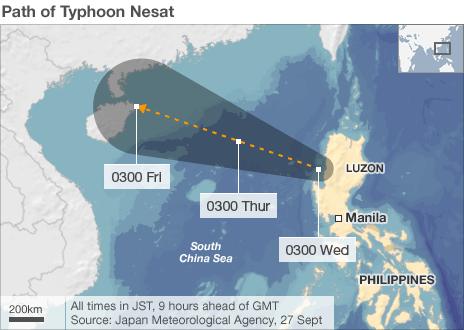Philippines cleans up after Typhoon Nesat
- Published
Kate McGeown reports on the evacuation efforts
A huge clean-up operation is under way in the Philippines after Typhoon Nesat battered the capital Manila and the main island, Luzon.
The death toll rose to 18 with 35 still missing after heavy rain and powerful winds triggered storm surges.
Most deaths occurred in and around Manila, officials said.
Nesat is now in the South China Sea with 120km/h (75mph) winds and due to reach China's Hainan Island on Thursday evening or early Friday.
Power supplies were gradually being restored to central Manila on Wednesday, officials said, and services on the Metro resumed.
However, more than a million people in Luzon remained without power.
Emergency teams were clearing away fallen trees, debris and broken-down cars while schools and offices reopened.
Civil defence chief Benito Ramos said crews were also repairing and clearing 61 road networks across Luzon damaged by landslides, debris and flooding.
Some areas are still under water including Manila Ocean Park and Taft Avenue. The US Embassy, which was flooded on Tuesday, remained closed.
City Mayor Alfredo Lim said huge waves had breached the sea wall allowing water from Manila Bay to engulf wide areas.
"This is the first time that this kind of flooding happened here," he said.
Flooding in Luzon was made worse when the government released water from four dams that had reached critical levels in Bulacan province.
Meanwhile, another tropical storm brewing in the Pacific Ocean could hit the Philippines within the week, the state weather bureau warned.
"We need to finish emergency work in the aftermath of Nesat before this storm comes," Mr Ramos said.
"We are praying for the skies to clear a little bit today."
Nesat, which had a diameter of 650km (400 miles) and carried gusts of up to 170km/h (105 mph), made landfall just before dawn on Tuesday on the Pacific coast.
The Philippines suffers frequent typhoons but Nesat is thought to be the largest this year.
It comes almost exactly two years after Typhoon Ketsana killed more than 400 people.

- Published28 September 2011
- Published27 July 2011